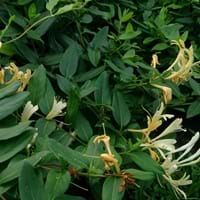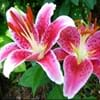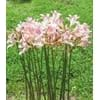Life Span
Perennial
Perennial
Type
Bulb or Corm or Tuber
Flowering Plants, Shrubs
Origin
Hybrid origin, North America, Europe, Africa, Asia
Eastern Asia
Types
White lily, orange lily, Lily of the valley
Not Available
Habitat
Not Available
Barren waste areas, disturbed sites, Fields, Forests, Wet lands
USDA Hardiness Zone
2-8
4-11
AHS Heat Zone
8-1
Not Available
Sunset Zone
21,22
Not Available
Habit
Upright/Erect
Cushion/Mound-forming
Flower Color
White, Yellow, Red, Green, Purple, Gold, Pink, Rose, Peach, Burgundy, Bronze
White, Yellow
Flower Color Modifier
Bicolor
Bicolor
Fruit Color
Yellow green, Sandy Brown
Black
Leaf Color in Spring
Green, Dark Green
Green
Leaf Color in Summer
Light Green
Green
Leaf Color in Fall
Several shades of Green
Green
Leaf Color in Winter
Light Green
Green
Leaf Shape
Long Linear
Oval
Plant Season
Spring, Summer, Fall
Summer
Sunlight
Full Sun, Partial Sun, Partial shade
Full Sun, Partial shade
Growth Rate
Medium
Medium
Type of Soil
Clay, Loam, Sand
Well drained
The pH of Soil
Acidic, Neutral, Alkaline
Neutral
Soil Drainage
Well drained
Well drained
Bloom Time
Not Available
Late Winter, Spring, Summer
Tolerances
Drought
Drought
Where to Plant?
Container, Ground, Pot
Ground
How to Plant?
From bulbs, Seedlings, Seperation
Layering, Seedlings, Stem Cutting
Plant Maintenance
Medium
Medium
Watering Requirements
Do Not over Water
Get enough water whenever the soil is dry
In Summer
Lots of watering
Lots of watering
In Spring
Moderate
Moderate
In Winter
Average Water
Average Water
Soil pH
Acidic, Neutral, Alkaline
Neutral
Soil Type
Clay, Loam, Sand
Well drained
Soil Drainage Capacity
Well drained
Well drained
Sun Exposure
Full Sun, Partial Sun, Partial shade
Full Sun
Pruning
Prune in early spring, Prune in fall, Remove dead or diseased plant parts
Remove dead or diseased plant parts
Fertilizers
Compost, Fertilize only when soil is poor, Organic Flower Fertilizer
All-Purpose Liquid Fertilizer, General garden fertilizer
Pests and Diseases
Aphids, Lily Beetle, Stem canker
Not Available
Plant Tolerance
Drought
Drought
Flower Petal Number
Single
Single
Foliage Texture
Not Available
Not Available
Foliage Sheen
Not Available
Not Available
Attracts
Birds, Hummingbirds, Not Available, Snails
Bees, Birds, Butterflies
Allergy
Mild Allergen, Not Available, sneezing
poisonous if ingested, Skin irritation
Aesthetic Uses
Beautification, Showy Purposes
Showy Purposes
Beauty Benefits
Making cosmetics
Not Available
Environmental Uses
Fixes Nitrogen, Indoor Air Purification
Air purification, Food for birds
Medicinal Uses
Burns, Diuretic, Heart problems
Fever, Sore throat, Stomach aliments
Part of Plant Used
Whole plant
Flowers, Leaves
Other Uses
Application in Handicrafts, Basketary, Cosmetics, Oil is used for aromatherapy, Oil is used in mosquito repellents, Used as Ornamental plant, Used for its medicinal properties
Making Perfumes, Used as Ornamental plant, Used for its medicinal properties
Used As Indoor Plant
Yes
No
Used As Outdoor Plant
Yes
Yes
Garden Design
Alpine, Container, Cutflower, Feature Plant, Mixed Border, Wildflower
Container, Cutflower, Dried Flower/Everlasting, Groundcover, Mixed Border, Rock Garden / Wall
Botanical Name
LILIUM
Lonicera japonica
Common Name
Lily
Japanese Honeysuckle, suikazura, jinyinhua
In Hindi
लिली
जापानी Honeysuckle
In German
Lilie
Japanese Honeysuckle
In French
Lis
Chèvrefeuille japonais
In Spanish
Lirio
madreselva japonesa
In Greek
Κρίνος
Το ιαπωνικό αγιόκλημα
In Portuguese
Lírio
Honeysuckle japonês
In Polish
Lilia
wiciokrzew japoński
In Latin
lilium
CISSANTHEMOS Italica
Phylum
Tracheobionta
Magnoliophyta
Class
Liliopsida
Magnoliopsida
Order
Liliales
Dipsacales
Family
Liliaceae
Caprifoliaceae
Clade
Angiosperms, Monocots
Angiosperms, Asterids, Eudicots
Tribe
Lilieae
Not Available
Subfamily
Lilioideae
Not Available
Season and Care of Trumpet Lily and Japanese Honeysuckle
Season and care of Trumpet Lily and Japanese Honeysuckle is important to know. While considering everything about Trumpet Lily and Japanese Honeysuckle Care, growing season is an essential factor. Trumpet Lily season is Spring, Summer and Fall and Japanese Honeysuckle season is Spring, Summer and Fall. The type of soil for Trumpet Lily is Clay, Loam, Sand and for Japanese Honeysuckle is Well drained while the PH of soil for Trumpet Lily is Acidic, Neutral, Alkaline and for Japanese Honeysuckle is Neutral.
Trumpet Lily and Japanese Honeysuckle Physical Information
Trumpet Lily and Japanese Honeysuckle physical information is very important for comparison. Trumpet Lily height is 30.00 cm and width 30.00 cm whereas Japanese Honeysuckle height is 800.00 cm and width 800.00 cm. The color specification of Trumpet Lily and Japanese Honeysuckle are as follows:
Trumpet Lily flower color: White, Yellow, Red, Green, Purple, Gold, Pink, Rose, Peach, Burgundy and Bronze
Trumpet Lily leaf color: Green and Dark Green
Japanese Honeysuckle flower color: White and Yellow
- Japanese Honeysuckle leaf color: Green
Care of Trumpet Lily and Japanese Honeysuckle
Care of Trumpet Lily and Japanese Honeysuckle include pruning, fertilizers, watering etc. Trumpet Lily pruning is done Prune in early spring, Prune in fall and Remove dead or diseased plant parts and Japanese Honeysuckle pruning is done Remove dead or diseased plant parts. In summer Trumpet Lily needs Lots of watering and in winter, it needs Average Water. Whereas, in summer Japanese Honeysuckle needs Lots of watering and in winter, it needs Average Water.





